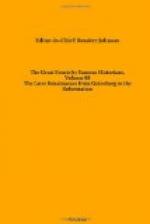as it would be difficult to surpass. In this fine extent of wood and verdure the Pope’s villa or casino, now the only summer palace which the existing Pontiff chooses to permit himself, stands as in a domain, small yet perfect. Almost everything within these walls has been built or completely transformed since the days of Nicholas. But, then as now, here was the heart and centre of Christendom, the supreme shrine of the Catholic faith, the home of the spiritual ruler whose sway reaches over the whole earth. When Nicholas began his reign, the old Church of St. Peter was the church of the Western world, then, as now, classical in form, a stately basilica without the picturesqueness and romantic variety, and also, as we think, without the majesty and grandeur, of a Gothic cathedral, yet more picturesque if less stupendous in size and construction, than the present great edifice, so majestic in its own grave and splendid way, with which, through all the agitations of the recent centuries, the name of St. Peter has been identified. The earlier church was full of riches and of great associations, to which the wonderful St. Peter’s we all know can lay claim only as its successor and supplanter. With its flight of broad steps, its portico and colonnaded facade crowned with a great tower, it dominated the square, open and glowing in the sun, without the shelter of the great existing colonnades or the sparkle of the fountains.
Behind was the little palace begun by Innocent III, to afford a shelter for the popes in dangerous times, or on occasion to receive the foreign guests whose object was to visit the shrine of the apostles. Almost all the buildings then standing have been replaced by greater, yet the position is the same, the shrine unchanged, though everything else then existing has faded away, except some portion of the old wall which enclosed this sacred place in a special sanctity and security, which was not, however, always respected. The Borgo was the holiest portion of all the sacred city. It was there that the blood of the martyrs had been shed, and where from the earliest age of Christianity their memory and tradition had been preserved. It was not necessary for us to enter into the question whether St. Peter ever was in Rome, which many writers have laboriously contested. So far as the record of the Acts of the Apostles is concerned, there is no evidence at all for or against, but tradition is all on the side of those who assert it. The position taken by Signor Lanciani on this point seems to us a very sensible one. “I write about the monuments of ancient Rome,” he says, “from a strictly archaeological point of view, avoiding questions which pertain, or are supposed to pertain, to religious controversy.




